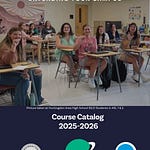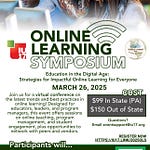Greetings WOL Friends!
This week Cortney Verostick and I dove into a conversation about online learning and the differences and similarities with the traditional classroom. As you will hear in the podcast - Cortney faced a variety of challenges with parenting - so I jumped in. You can read more below.
We love that teaching PE and Health online can be a lifeline to get student to graduate. PE and Health are courses that for some reason - high school students just don’t take seriously - until it comes to graduation time (another podcast episode could happen here).
So if you need credit recovery for PE and Health or other subjects please reach out via email at pmulroy @ iu08.org or click here for more information.
Have a great week!
Pat
We have an awesome Online Learning Symposium on March 26th. The event offers live session and recordings for future use. You can 📌 Register now: https://iu17.link/2025OLS or contact me for more information.
Online vs. Traditional Learning: My On the Job Experience - Comparing the benefits and challenges of online and traditional classroom settings
Unbeknownst to me, my last day in the Physical Education classroom was June of 2000. I had completed my administrative coursework and was set to do an internship - that turned into a Teacher on Special Assignment. I didn’t have a hanging up of the golden sneakers or ceremonial end to my time in the classroom. It felt like yesterday….
Until….
Our very capable PE teacher had a series of unexpected events. Parenthood caught up. So I stepped in. I didn’t take the assignment lightly. In fact, I was terrified. As a leader I had all kinds of experience in helping teachers to transition to teaching online. I have even done a bit of teaching ADULTS. Not children!
As I thought about our Gold Standard for the classroom: authentic, relevant and engaging, I wondered if I could live up to the standard our amazing VLF’s demonstrate every day?
This school year we did professional learning about the theory behind good online instruction - The Community of Inquiry Theory. We dove in. We hosted an in-person end of the year Professional Learning event, we created courses for everyone to participate before the start of the school year, and we have hosted Professional Learning Communities (PLC’s).
How would I include all this as I took over teaching Health and Physical Education?
.
So did I measure up as a teacher/virtual learning facilitator?
My tech skills were low for teaching kids! But I made up for the low skill in tech with high skill in welcoming students to the room and I got to know a little bit about them. That was the best part!
I was out of the loop on the newest Physical Education trends. I made up for it by including dance and movement activities that relate to brain development - hoping to improve outcomes in other classes like reading, math, and executive functioning.
I was overwhelmed! Providing feedback for every assignment, a Monday Morning Message, and emails to students who were behind is hard work and time consuming. Also, uploading class recordings and planning for live sessions took more time than I remembered!
How does it compare to teaching in a brick and mortar school?
My only experience teaching young people before this short stint of teaching Health and PE again, was in a gym, on a field, or classroom. My age and relatability - and lack of confidence had me terrified. I realized though that in finding out what the students are good at and interested in filled in the gap.
These are a few of the differences I noticed:
It is easier to get to know students when you have proximity to them. Facial expressions, body language and observation are more visible in-person. But, surprisingly, the virtual environment offered its own unique ways to connect. While I couldn’t rely on physical presence or quick hallway check-ins, I found that intentional communication became the bridge to relationships. Messaging students individually, recognizing their efforts in a Monday Morning Message, and responding to their reflections made engagement feel more personal—perhaps even more so than in a traditional setting, where casual interactions can sometimes be taken for granted or shared with more outgoing students. .
Another key difference? Pacing and flexibility. In a physical classroom, I could adjust in real time based on students’ energy levels or engagement cues. Online, that adjustment had to be built into the structure—creating space for self-paced learning, adding opportunities for movement, and making sure live sessions were interactive rather than passive. While it required more planning upfront, the payoff was a more student-centered experience.
And finally, feedback took on a different role. In-person, I could give a quick nod of approval, a high five, or a verbal cue to guide students. Online, every comment had to be deliberate and specific. I gained a deeper appreciation for how well-crafted feedback shapes student motivation and progress. The extra time it took was an investment—but one that clearly mattered.
Final Reflections:
So, did I measure up? Maybe not perfectly. But I learned, adapted, and grew—just as we ask our students to do every day. While both traditional and online teaching have their challenges and advantages, this experience reminded me that at the core of all great learning is connection, adaptability, and a willingness to meet students where they are—whether in a gym, a classroom, or a virtual space.
AI use disclaimer: I used AI to review for grammar and syntax mistakes.
Join us for our inaugural Online Learning Symposium!
We’d love to have you join us and become part of a new community of educators gathering annually to sharpen their skills and re-energize for the end of the school year!
📌 Register now: https://iu17.link/2025OLS















Share this post